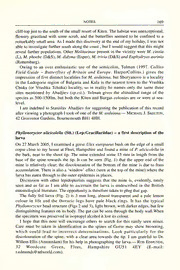
Phyllonorycter ulicicolella (Stt.) (Lep: Gracillariidae) - a first description of the larva PDF
Preview Phyllonorycter ulicicolella (Stt.) (Lep: Gracillariidae) - a first description of the larva
NOTES 169 cliff-topjustto the south ofthe small resortofKiten. The habitat was unexceptional, flowery grassland with some scrub, and the butterflies seemed to be confined to a remarkably small area. As I made this discovery at the end ofmy holiday, I was not able to investigate further south along the coast , but I would suggest that this might reveal further populations. Other Melitaeinae present in the vicinity were M. cinxia (L), M. phoebe (D&S),M. didyma (Esper),M. trivia (D&S) andEuphydryas aurinia (Rottemburg). Owing to an over enthusiastic use of the semicolon, Tolman (1997. Collins Field Guide - Butterflies ofBritain and Europe. HarperCollins.) gives the impression offive distinct localities forM. arduinna, but Sboryanovo is a locality in the Ludogorie region of Bulgaria and Kula is the nearest town to the Vrashka Chuka (or Vrushka Tchuka) locality, so in reality he names only the same three sites mentioned by Abadjiev (op.cit.). Tolman gives the altitudinal range of the species as 500-1500m, but both the Kiten and Burgas colonies are or were at sea- level. I am indebted to Stanislav Abadjiev for suggesting the pu—blication ofthis record afterviewing aphotograph I took ofone oftheM. arduinna. MichaelJ. Skelton, 42 GrosvenorGardens, Bournemouth BHl 4HH. Phyllonorycter ulicicolella (Stt.) (LepiGracillariidae) - a first description ofthe larva On 27 March 2005, I examined a gorse Ulex europaeus bush on the edge ofa small copse close to my house at Fleet, Hampshire and found a mine ofP. ulicicolella in the bark, near to the shoot tip. The mine extended some 15 mm in length from the base of the spine towards the tip. It can be seen (Fig. 1) that the upper end of the mine is relatively clear; the discolouration ofthe bottom ofthe mine is due to frass accumulation. There is also a 'window' effect (seen atthe top ofthe mine) where the larvahaseatenthrough to the outerepidermis inplaces. Discussion with other lepidopterists suggests that the mine is, evidently, rarely seen and as far as I am able to ascertain the larva is undescribed in the British entomological literature. The opportunity is thereforetakentoplugthatgap. mm The fully fed larva (Fig. 2) is 3 long, almost transparent and a pale lemon colour in life and the thoracic legs have pale black rings. It has the typical Phyllonorycterhead structure (Figs 2 and 3), lightbrown, with darkeredges, butfew distinguishing features on its body. The gutcan be seen through the body wall.When the specimen was preservedin isopropyl alcohol it lost its colour. I hope that this note will encourage others to search for this rarely seen miner. Care must be taken in identification as the spines of Gorse may show browning, which could lead to incorrect determinations. Look particularly for the discolouration of the spine, with a clear area towards the tip. I a—m grateful to Dr. Willem Ellis (Amsterdam) forhis help in photographing the larva. Rob Edmunds, 32 Woodcote Green, Fleet, Hampshire GU51 4EY (E-mail: [email protected]). 170 ENTOMOLOGIST'SRECORD,VOL. 117 25.vii.2005 Fig. 1.LarvalmineofPhyllonorycterulicicolella. Fig.2.FinalinstarofPhyllonorycterulicicolella(ventral). Fig.4.Phyllonorycterulicicolellaheadand thoracicregion(ventral)
